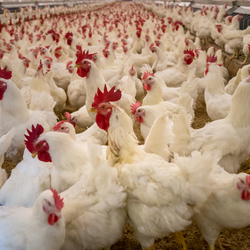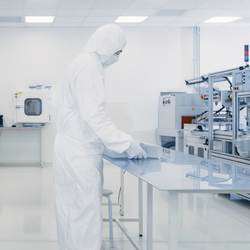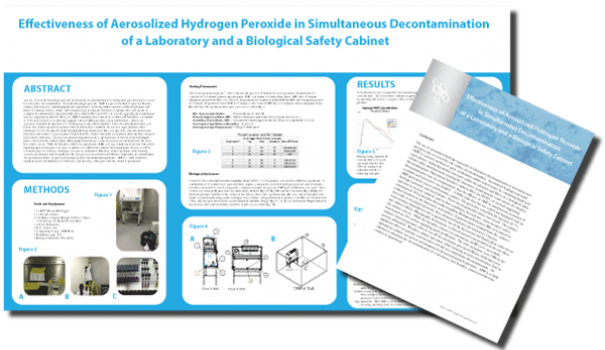Tips to Keep Avian Influenza from Flying the Coop
 A recent outbreak of the formidable avian influenza (bird flu) has quickly spread across Europe and the United States, infecting birds both in the wild and those housed in commercial poultry farms. Avian influenza is highly pathogenic to birds yet remains considerably rare in humans. When human infection does occur, it has been shown to transfer via feces and saliva. The mortality rate can be up to 60% for people and 90% for birds. This high mortality rate is concerning for infectious disease experts and extreme care must be taken when researching this virus. It is no secret that biocontainment labs across the globe can have lapses in containment policies which can lead to outbreaks. Implementing automated disinfection in containment laboratories can be a valuable resource in preventing hazardous cross contamination of organisms that can lead to exposure or lab leaks.
A recent outbreak of the formidable avian influenza (bird flu) has quickly spread across Europe and the United States, infecting birds both in the wild and those housed in commercial poultry farms. Avian influenza is highly pathogenic to birds yet remains considerably rare in humans. When human infection does occur, it has been shown to transfer via feces and saliva. The mortality rate can be up to 60% for people and 90% for birds. This high mortality rate is concerning for infectious disease experts and extreme care must be taken when researching this virus. It is no secret that biocontainment labs across the globe can have lapses in containment policies which can lead to outbreaks. Implementing automated disinfection in containment laboratories can be a valuable resource in preventing hazardous cross contamination of organisms that can lead to exposure or lab leaks.
Risks Associated with Avian Influenza in Laboratory Settings
The most common strains being studied are the highly infectious H5N1 and H7N9 variants that can survive for extended periods of time on fomites (hard surfaces) and in water. These have been implicated in causing outbreaks throughout Asia and have infected about 600 people worldwide. Currently, the virus is being studied and manipulated in at least 14 BSL-3 and BSL-4 laboratories across the globe. Some cross-contamination within the same lab may occur when there has been improper disinfection between pathogens and two separate research experiments may interact with one another. For example, in 2014, an instance was reported of a harmless sample of bird flu (H9N2) being given to fellow laboratory, where that sample later became cross-contaminated with H5N1, a highly pathogenic strain of bird flu.  One way to avoid this may be to review disinfection procedure failures in that laboratory and develop a risk-based approach to containment. Similar mistakes have also occurred with other deadly pathogens like anthrax. These shortcomings emphasize the growing need for safer decontamination in these high-containment laboratories and highlight the potential gaps in current procedures.
One way to avoid this may be to review disinfection procedure failures in that laboratory and develop a risk-based approach to containment. Similar mistakes have also occurred with other deadly pathogens like anthrax. These shortcomings emphasize the growing need for safer decontamination in these high-containment laboratories and highlight the potential gaps in current procedures.
Challenges in Decontaminating Against Avian Influenza
Preventing cross-contamination of pathogenic variants requires the high-level disinfection of both the laboratory space as a whole and the specialized containment equipment within it. BSL-2, BSL-3, and BSL-4 laboratories often rely on laboratory equipment to perform their work safely with pathogenic organisms and help prevent splashes that can contaminate staff. Currently, there are challenges associated with decontamination efforts of this equipment. Caustic chemicals like formaldehyde, sodium hypochlorite (bleach), and chlorine dioxide often provide an efficacious disinfection treatment but may cause degradation or corrosion to costly equipment over time. Multiple chemicals also leave behind sticky residues that can trap microorganisms. These methods can also be time-consuming, laborious, and can miss certain areas.
HHP™ Technology for High-Level Disinfection in Laboratories
Employing CURIS System Hybrid Hydrogen Peroxide (HHP™) fogging technology allows for the simultaneous disinfection of both the biological safety cabinets and the laboratory space without sacrificing the durability of the equipment being used. This provides a safer way to complete whole space disinfection and can reach deep in the plenums and filters of the BSC. CURIS System employs a 7% hydrogen peroxide solution to achieve a consistent dwell time using patented Pulse™ technology. Geobacillus stearothermophilus biological indicators are placed in the decontamination space to validate a 6-log reduction (99.9999%) is achieved. Automated disinfection tools like CURIS System devices may help prevent human errors that can account for 67.2% of lab errors in BSL-2, BSL-3 and BSL-4 labs.
Effective Decontamination to Insure Against Viruses Like Avian Influenza
CURIS System is a proven efficacious resource in the laboratory space. In conjunction with The Baker Company, CURIS System devices were tested in a study where a 3000-cubic foot lab and a Class II Biological Safety Cabinet (BSC) were decontaminated simultaneously using a portable CURIS System HHP™ System. Over the testing period, 184 Geobacillus stearothermophilus biological indicators passed, indicating a 6-log (99.9999%) reduction and proving its efficaciousness in the laboratory space and demonstrating superior efficacy for any facility doing viral work which needs to insure against biocontainment lab leaks. Contamination of virulent or mutated pathogens like avian influenza remains a considerable concern.  However, incorporating an automated disinfection tool like gaseous HHP™ fogging technology can help protect your facility by decreasing exposure to pathogens and providing the same efficacious kill each time. To help find a CURIS System device for your laboratory facility visit our products page or learn more by reading, “Simultaneous Decontamination of a Laboratory and a Biological Safety Cabinet.”
However, incorporating an automated disinfection tool like gaseous HHP™ fogging technology can help protect your facility by decreasing exposure to pathogens and providing the same efficacious kill each time. To help find a CURIS System device for your laboratory facility visit our products page or learn more by reading, “Simultaneous Decontamination of a Laboratory and a Biological Safety Cabinet.”
References:
1. Centers for Disease Control and Prevention. (2018, December 11). Highly pathogenic asian avian influenza A(H5N1) in people. Centers for Disease Control and Prevention. Retrieved March 17, 2022
2. Jacobs, A. (2022, February 24). Avian flu spread in the U.S. worries Poultry Industry. The New York Times. Retrieved March 17, 2022, from https://www.nytimes.com/2022/02/24/science/avian-flu-us-poultry.html
3. 王淑卿. (n.d.). Avian flu spreads in several US states. Chinadaily.com.cn. Retrieved March 17, 2022, from https://global.chinadaily.com.cn/a/202203/02/WS621eeceea310cdd39bc89ce1.html
4. World Health Organization. (2022, March 17). Human infection with influenza A(H5N1). World Health Organization. Retrieved March 17, 2022
5. Guardian News and Media. (2014, July 18). From anthrax to Bird Flu – the dangers of LAX security in disease-control labs. The Guardian. Retrieved March 17, 2022, from https://www.theguardian.com/world/2014/jul/18/anthrax-bird-flu-dangers-lax-security-disease-control-labs
6. Klotz, L. C., & Sylvester, E. J. (1AD, January 1). The consequences of a lab escape of a potential pandemic pathogen. Frontiers. Retrieved March 17, 2022, from https://www.frontiersin.org/articles/10.3389/fpubh.2014.00116/full